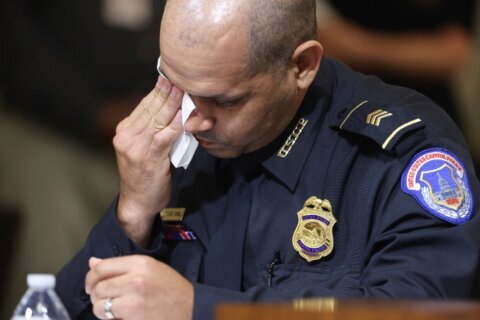Listen live for the latest weather updates on the 8s on WTOP.
D.C.-area residents are seeing, and smelling, effects on the air quality caused by smoke from Canadian wildfires pushing into the District on Wednesday.
The smoke is adding to levels of fine particle pollution and some D.C.-area residents have already noticed the effects.
“We haven’t seen something like this, with smoke ground level in over 10 years,” said 7News First Alert Meteorologist Eileen Whelan.
Air quality is expected to be poor throughout the D.C. region on Wednesday and into the coming days.
Though the air could be unhealthy for anyone, kids, the elderly and those with respiratory or heart ailments should be especially cautious, according to the Metropolitan Washington Council of Governments.
“You could experience headaches, irritated eyes, fatigue maybe breathing difficulties, some chest pain,” she said. “As nice as it may feel in some ways, you really want to take it easy outside.”
Here’s what you need to know.
What should residents do when air quality is down?
Most of the region is bouncing between code orange or code red alerts. 7News First Alert Meteorologist Brian van de Graaff said “the bottom line is to limit your time outdoors.”
On days with poor air quality, Metropolitan Washington Council of Governments recommends kids and older adults reduce their time outdoors.
People with respiratory or heart ailments should limit their activity and if breathing becomes difficult, move indoors, the council said.
“They will experience health effects, particularly if they are outside doing some kind of activity and that’s why we’re suggesting to stay indoors as much as possible,” Kumar said.
People who are outside of those groups should limit strenuous work or exercise, particularly while outside.
Here’s what else residents can do on unhealthy air days, according to the Council of Governments:
- Turn off lights and electronics to use less electricity to cool your home.
- Avoid lawn mowing or use an electric mower.
- Use public transit, carpool or work remotely to limit driving. Wait until the evening to fill up your gas tank.
Orange haze to stick around
“People might have already noticed, the sun seemed kind of dim and blurry,” Sunil Kumar, an environmental engineer with the Council of Governments, told WTOP. “It’s covering a wide area and its blocking the sun.”
Smoke is present across much of the region reducing visibility and causing unhealthy levels of air quality. #DCwx #MDwx #VAwx #WVwx pic.twitter.com/V5wns5Yh8Q
— NWS Baltimore-Washington (@NWS_BaltWash) June 7, 2023
That hazy sunshine is expected to be apart of the region’s forecast for a couple of days, van de Graaff said.
“The wildfire smoke is still a major part of our forecast, keeping that sky someway opaque,” he said, adding that the smoke will make for an orange-look to the moon, as well as sunsets and rises.
Visibility is on average around 2 miles, as of 9:30 a.m., according to Whelan. But visibility is expected to improve throughout the day, especially in the western zone.
Wednesday night the smoke is expected to thicken and lower again, Whelan said.
Thursday’s forecast calls for more of the same in the way of unhealthy air.
The smoke is expected to be pushed out of the D.C. region heading into the weekend.
You can check current air quality conditions online for Maryland, Virginia and the District.
School changes
D.C. public schools won’t hold outdoor activities such as recess and sports.
Public schools in Charles County, Maryland, canceled or rescheduled outdoor plans. The same goes for Montgomery County public schools for both Wednesday and Thursday.
In Virginia, Fairfax County Public Schools also called off outdoor activities from 11 a.m. and 6 p.m.
You can see a list of school changes on the WTOP’s Closings & Delays page.
Forecast
WEDNESDAY: Hazy sun. Northwest winds ranging 10-15 mph. Highs around 80.
WEDNESDAY NIGHT: Hazy skies. Lows in the mid and upper 50s.
THURSDAY: Hazy sun. Stray PM shower. Highs in the upper 70s.
FRIDAY: Partly cloudy morning followed by increasing clouds with showers developing later. Highs in the upper 70s.
WTOP’s Nick Iannelli contributed to this report.








